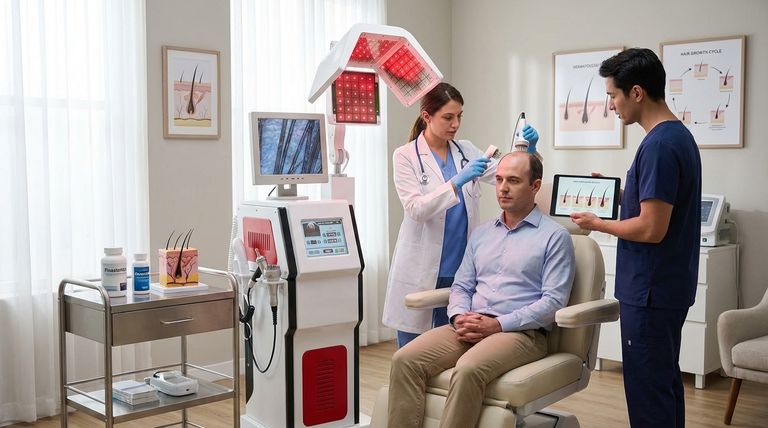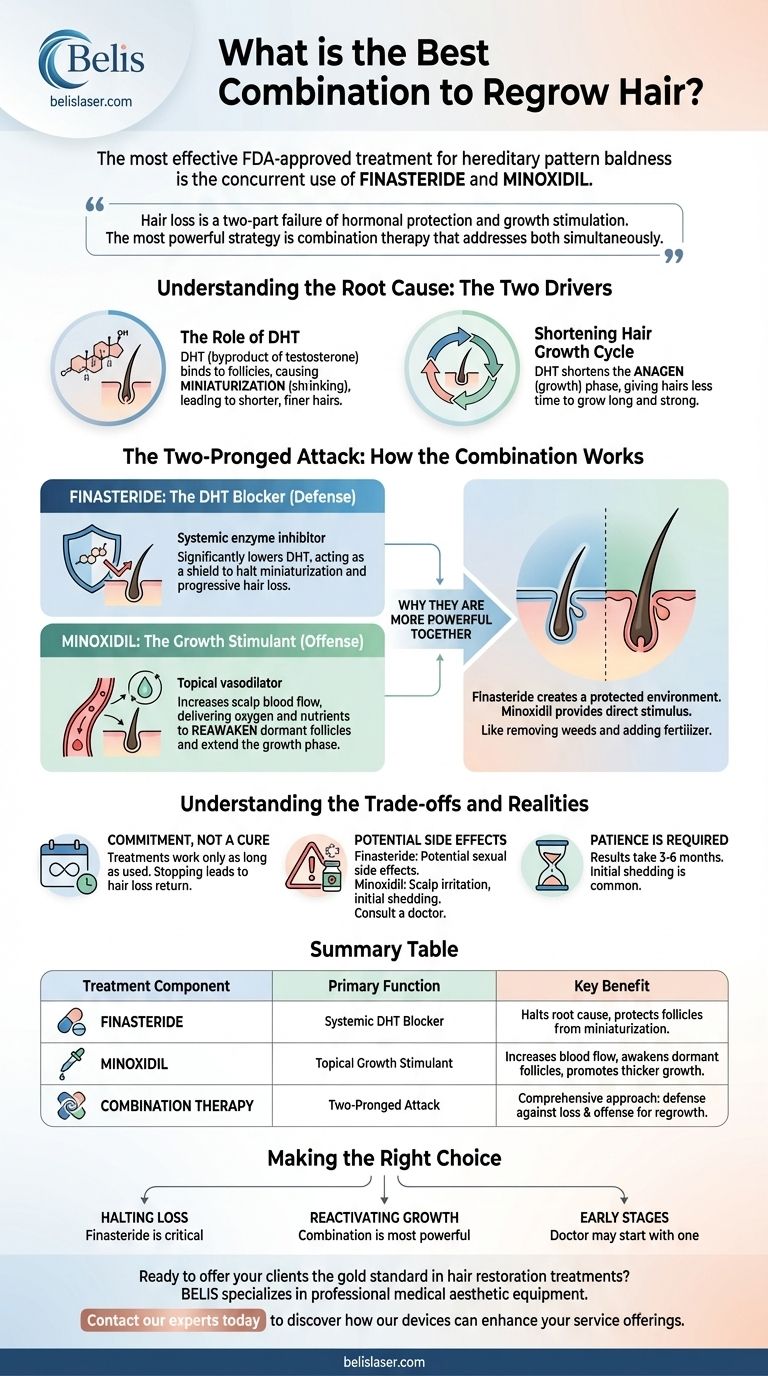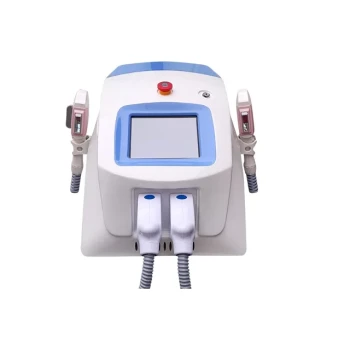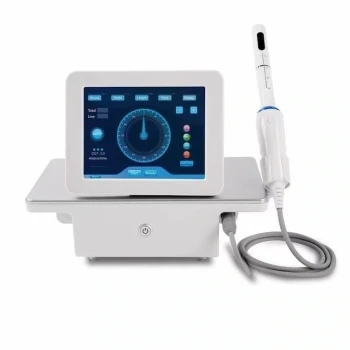For treating hereditary pattern baldness, the most effective combination backed by clinical evidence and FDA approval is the concurrent use of finasteride and minoxidil. Finasteride works systemically to stop the underlying hormonal cause of hair loss, while topical minoxidil works directly on the scalp to stimulate the hair follicles and encourage new growth. Together, they form a comprehensive, two-pronged approach.
Hair loss is not a single problem; it's a two-part failure of hormonal protection and growth stimulation. The most powerful strategy, therefore, is not a single magic bullet but a combination therapy that addresses both of these failures simultaneously.

Understanding the Root Cause: The Two Drivers of Hair Loss
To understand why the combination is so effective, you must first understand the two distinct biological processes that cause androgenetic alopecia (pattern hair loss).
The Role of DHT (Dihydrotestosterone)
The primary culprit behind genetic hair loss is a hormone called DHT. It is a byproduct of testosterone.
In individuals with a genetic predisposition, DHT binds to receptors in hair follicles on the scalp. This binding triggers a process called miniaturization, where the follicle progressively shrinks, producing shorter, finer hairs with each cycle until it eventually stops producing hair altogether.
The Shortening Hair Growth Cycle
Every hair on your head goes through a cycle: a growth phase (anagen), a transition phase (catagen), and a resting phase (telogen).
In pattern baldness, DHT not only shrinks the follicle but also shortens the anagen (growth) phase. This means hairs have less time to grow long and strong before they are shed, contributing to the appearance of thinning.
The Two-Pronged Attack: How the Combination Works
Using finasteride and minoxidil together is like deploying both a defensive and an offensive strategy. One protects the follicles from further damage, while the other actively stimulates them to grow.
Finasteride: The DHT Blocker (Defense)
Finasteride is an enzyme inhibitor. It works by blocking the enzyme (5-alpha reductase) that converts testosterone into the follicle-damaging DHT.
By significantly lowering DHT levels in your system, finasteride effectively removes the primary trigger for miniaturization. It acts as a shield, protecting your hair follicles from the hormonal assault that causes them to shrink and die off. This is crucial for halting the progression of hair loss.
Minoxidil: The Growth Stimulant (Offense)
Minoxidil is a vasodilator, meaning it widens blood vessels. When applied topically to the scalp, it increases blood flow to the hair follicles.
This enhanced circulation delivers more oxygen, blood, and nutrients directly to the follicle. This process helps to reawaken dormant follicles and extends the anagen (growth) phase, allowing hairs to grow thicker and longer.
Why They Are More Powerful Together
The synergy between the two is what makes the combination the gold standard.
Finasteride creates a healthier, low-DHT environment where follicles are no longer under attack. Minoxidil then works within that protected environment to provide the direct stimulus needed for robust growth. Think of it as first removing the weeds from a garden (finasteride) and then adding fertilizer to help the flowers grow (minoxidil).
Understanding the Trade-offs and Realities
While this combination is highly effective, it is essential to have realistic expectations and understand the commitment involved.
It's a Commitment, Not a Cure
These treatments are not a permanent cure for baldness. They work only as long as you continue to use them.
If you stop treatment, DHT levels will return to normal, and the growth-stimulating effects of minoxidil will cease. Any hair that was maintained or regrown due to the medication will likely be lost within several months.
Potential Side Effects
Both medications have potential side effects. Finasteride can, in a small percentage of men, cause sexual side effects. Minoxidil can cause scalp irritation, dryness, or an initial period of shedding as new hairs push out old ones.
It is critical to discuss these potential risks with a doctor to determine if the treatment is appropriate for you.
Patience Is Required
Results are not immediate. It typically takes 3-6 months of consistent daily use to begin seeing noticeable improvement, with the full effects often taking a year or more to become apparent. An initial shedding phase in the first few weeks is common and often a sign the treatment is working.
Making the Right Choice for Your Goal
Consulting a dermatologist is the essential first step to confirm your diagnosis and create a personalized treatment plan. Based on your specific situation, the approach can be tailored.
- If your primary focus is halting further loss and preserving what you have: Finasteride is the critical component, as it addresses the root hormonal cause of progression.
- If your primary focus is reactivating growth in thinning areas: The combination of finasteride and minoxidil is the most powerful approach, as one protects the follicle while the other stimulates it.
- If you are in the very early stages of thinning: A doctor may recommend starting with just one medication, often finasteride, to see how you respond before adding the second.
By understanding the mechanisms behind hair loss, you can make an informed decision on the most effective path to managing it.
Summary Table:
| Treatment Component | Primary Function | Key Benefit |
|---|---|---|
| Finasteride | Systemic DHT Blocker | Halts the root cause of hair loss by protecting follicles from miniaturization. |
| Minoxidil | Topical Growth Stimulant | Increases blood flow to the scalp to awaken dormant follicles and promote thicker growth. |
| Combination Therapy | Two-Pronged Attack | Provides the most comprehensive approach: defense against loss and offense for regrowth. |
Ready to offer your clients the gold standard in hair restoration treatments?
BELIS specializes in professional medical aesthetic equipment for clinics and premium salons. Equip your practice with the tools needed to deliver effective, evidence-based solutions like combination therapy.
Contact our experts today to discover how our devices can enhance your service offerings and help your clients achieve their hair regrowth goals.
Visual Guide

Related Products
- Multifunctional Laser Hair Growth Machine Device for Hair Growth
- Diode Laser SHR Trilaser Hair Removal Machine for Clinic Use
- Trilaser Diode Hair Removal Machine for Beauty Clinic Use
- IPL SHR Hair Removal Machine for Permanent Hair Removal
- Clinic Diode Laser Hair Removal Machine with SHR and Trilaser Technology
People Also Ask
- How often should you do laser hair regrowth? A Guide to the Two-Phase Treatment Schedule
- What does the SHR do? The Gentle, Pain-Free Revolution in Laser Hair Removal
- Are laser hair growth devices safe? A Guide to Safe & Effective At-Home Treatment
- Which frequency is best for hair growth? Discover the Science Behind 50 Hz EMF Therapy
- How effective is LLLT for hair? Clinically Proven to Boost Hair Growth by 35%



















